The Great Indian Desert Class 4 Notes SST
| Table of contents |

|
| What are Deserts? |

|
| The Great Indian Desert |

|
| Climate |

|
| Flora |

|
| Water Sources |

|
| Houses and Infrastructure |

|
| Festivals and Culture |

|
| Tourist Attractions |

|
| Things to Remember |

|
What are Deserts?
Deserts are dry places where it hardly ever rains. They can be very hot during the day and quite cold at night. Because there's so little water, not many plants can grow there, and the ground is often sandy or rocky.
 Desert
Desert
The Great Indian Desert
India has a desert called the Thar Desert, which is in the northwest part of the country, mainly in Rajasthan.
- The Thar Desert is characterized by vast stretches of sand dunes, an arid climate, and extreme temperatures, making it one of the hottest regions in India during the summer months.
- The Thar Desert is situated in the northwestern part of India, primarily spanning the state of Rajasthan. It extends into parts of Gujarat, Punjab, and Haryana.
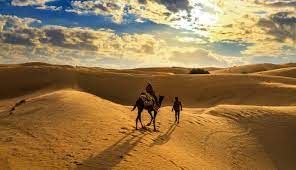 Thar Desert- India
Thar Desert- India
Climate
The desert stays hot and dry all the time. In summer, it gets really hot during the day, but the nights are cooler. In winter, the days are warm, but the nights become very cold.
- The desert doesn't get much rain, and the Aravalli Hills stop the winds that bring rain from reaching the area.
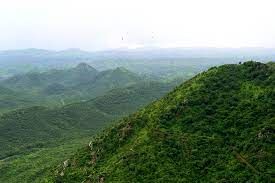 Aravalli Hills
Aravalli Hills - So, the desert gets very little rainfall, making it dry most of the time. This lack of rain and water sources makes it tough for plants and animals to survive in the desert.
- The plants and trees that do grow there have adapted to live with very little water.
- Overall, the desert has a special kind of weather with high temperatures, scarce rainfall, and a challenging environment for living things.
Flora
- In the desert, you can see scattered bushes and thorny shrubs in certain areas. In some spots, there are plants like palm, babool, cactus, and thorny kikar that don't need much water to survive.
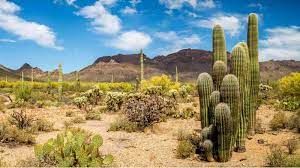
- Even though the conditions in the desert are tough, farmers still manage to grow crops like wheat, gram, jowar, and bajra in their fields. An example is the wheat farm at Suratgarh.
- Growing these crops in the desert is challenging because of the hot and dry climate with very little rainfall.
- Despite these difficulties, the farmers find ways to cultivate and harvest these crops to sustain themselves and their communities.
Water Sources
In the desert, finding water is not easy because there isn't much of it. However, in some places, there's a bit of water.
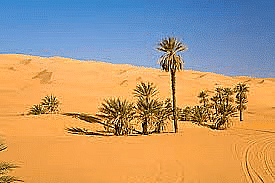
This water mostly comes from the small amount of rain that gathers in streams and ponds. Additionally, there's water underground that comes up, forming a little pool called an oasis.
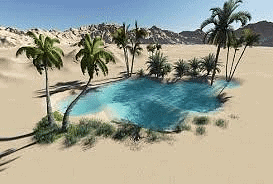 Oases
Oases
- People often build villages around these oases because they provide a source of water for drinking and growing crops.
- These spots are fertile, meaning they are good for growing plants. Date palm trees, which can thrive with limited water, are commonly found in these areas, providing both shade and a valuable source of food for the people living in the desert.
- So, these oases become important hubs where communities can settle and sustain themselves in the dry desert environment.
Houses and Infrastructure
- Houses in the desert are designed to withstand extreme weather conditions, with flat roofs, thick walls to insulate from heat, and underground tanks (taankas) to store rainwater.
- Infrastructure developments like the Indira Gandhi Canal and the presence of wells and water tanks have improved water accessibility for local communities.
Festivals and Culture
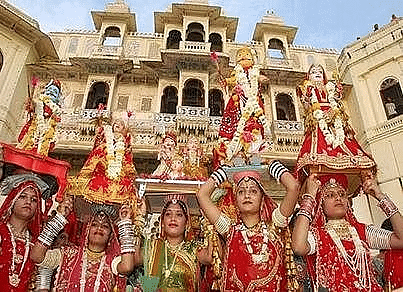
- Teej and Gangaur are especially festive occasions for women. During these celebrations, women participate in activities such as swinging on swings and singing traditional songs.
- These festivals hold special significance in the cultural traditions of Rajasthan, bringing communities together in joyous celebration.
- One of the highlights of these festivities is the Ghoomar dance, a famous folk dance of Rajasthan.
- This traditional dance is performed by women during special occasions and celebrations.
- The Ghoomar dance involves graceful movements, colorful attire, and rhythmic music, making it a captivating and integral part of Rajasthan's cultural heritage.
Tourist Attractions
- Meanwhile, Jaipur boasts landmarks like the distinctive Hawa Mahal and the grand Amber Fort.

- Other cities, such as Jodhpur, Bikaner, Kota, Alwar, and Chittor, are noteworthy for their rich historical significance. These places hold traces of the past, offering glimpses into the region's cultural and architectural heritage.
- Mount Abu serves as a hill station, providing a refreshing escape with its cooler climate compared to the surrounding desert.
- Meanwhile, the Dargah at Ajmer draws devotees, offering a spiritual experience.
Jaipur, being the capital, is famously known as the Pink City due to its distinctive pink-colored buildings. This unique architectural style was established by Raja Jai Singh, adding to the city's charm and making it a notable destination for visitors.
Things to Remember
- The Great Indian Desert covers the State of Rajasthan.
- Water is scarce in most parts. The soil is sandy.
- Camel is the ship of the desert lands.
- Farming is done in the eastern parts where there is some rainfall. Indira Gandhi Canal is also making water available for irrigation in many districts.
- Farming, goat rearing, mining and tourism provide most of the earnings in the State.
- People are brave and hard working. They wear bright clothes. Teej and Gangaur are popular festivals.
- Rajasthan has a rich tradition of folk dances.
- The cities are a big tourist attraction for their forts, festivals and palaces.
|
50 videos|246 docs|46 tests
|
FAQs on The Great Indian Desert Class 4 Notes SST
| 1. What is the climate like in the Great Indian Desert? |  |
| 2. What kind of flora can be found in the Great Indian Desert? |  |
| 3. How do people living in the Great Indian Desert source water for their daily needs? |  |
| 4. What type of houses and infrastructure can be seen in the Great Indian Desert region? |  |
| 5. What are some popular tourist attractions in the Great Indian Desert? |  |





















